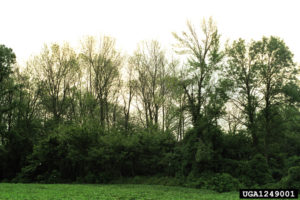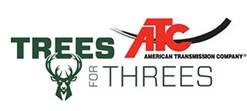Imagine that you waved a wand across your community and pollutants from hundreds of tail pipes and smoke stacks disappeared. Far-fetched, no? But that is what trees do every day, and a new tool could summarize some of the magic trees are performing to improve public health and infrastructure. Continue reading “Tree canopy cover benefits assessed using i-Tree Landscape”
Technical assistance
Public comment period for EAB silviculture guidelines revision closes October 9
By Bill McNee, forest health specialist, Oshkosh. Bill.McNee@wisconsin.gov; 920-360-0942

Ash trees dying from an EAB infestation. Photo: Troy Kimoto, Bugwood.org
The Wisconsin DNR is seeking public comments on a proposed revision to silviculture guidelines for emerald ash borer (EAB). Stand-level EAB silviculture guidelines were originally released in 2007, with periodic reviews and updates. A DNR technical team and stakeholder advisory committee prepared the current version using multiple sources of information, including recent research findings, identification and locations of new EAB infestations, economic considerations, and experience gained from implementing previous versions of the guidelines.
The draft document and information about the public comment process can be found at https://dnr.wi.gov/news/input/Guidance.html#open through Tuesday, October 9, 2018. All comments must be submitted by that date.
Professional sports work to plant trees
 The Milwaukee Bucks and American Transmission Co. (ATC) are bringing back their “Trees for Threes” initiative for the 2017-18 Milwaukee Bucks season. Through the Trees for Threes platform, the Bucks and ATC will sponsor the planting of a new tree in Wisconsin for every 3-pointer the Bucks make at home this season.
The Milwaukee Bucks and American Transmission Co. (ATC) are bringing back their “Trees for Threes” initiative for the 2017-18 Milwaukee Bucks season. Through the Trees for Threes platform, the Bucks and ATC will sponsor the planting of a new tree in Wisconsin for every 3-pointer the Bucks make at home this season.
Continue reading “Professional sports work to plant trees”
Urban Forestry Consultant Directory – Annual Update
Last year, the format of the DNR’s Urban Forestry Consultants Directory was updated, creating two versions; one searchable by county served and the other, an abbreviated version with companies listed alphabetically. As the application period for the next round of Urban Forestry Grants is fast approaching, we are seeking updates and additions to the consultants directory. Continue reading “Urban Forestry Consultant Directory – Annual Update”
Herbicide damage to trees
Herbicide damage can resemble other tree problems such as branch dieback, foliage discoloration, and premature leaf or needle drop. Look for certain clues to help narrow down whether it is a weather related issue, insect or disease issue, or a potential herbicide issue.
